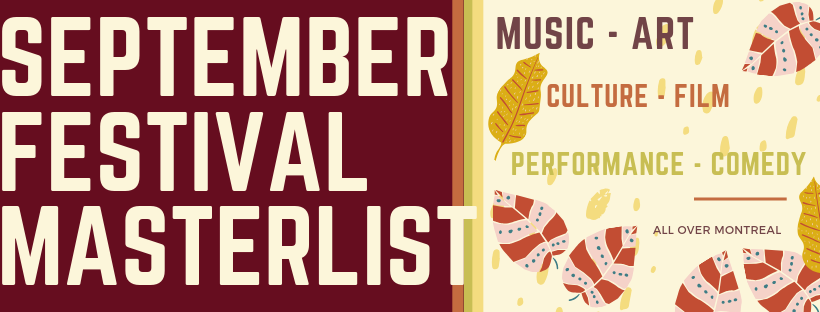Don’t get too cozy yet! The weather was strangely warm this week and it appears it’ll stay that way for another… so get off the couch! Take a study break and go check out these festivals happening all over Montreal this fall! Oh, and if you haven’t seen any part of the Momenta Biennale, do that too!
THIS WEEK
LadyFest
Returning for its fifth year, LadyFest is a comedy festival celebrating femme and non-binary talents. I had the opportunity to go last year and had such a great time! Did I mention that I went back to watch a show alone… and sat in the front row? I didn’t even anxiety-hurl! LadyFest is truly soul food. Anyway, this magnificent happening ends Saturday, Sept. 21, so get your tickets here or at Théatre St-Catherine. For more information visit http://ladyfest.ca
Feminist Film Festival
No one will be turned away for lack of funds at this intersectional film festival! With local and international film shorts, FFF promises to challenge gender norms and feature strong female leads.
The schedule is as follows:
Sept. 21 at Association des réalisateurs et réalisatrices du Québec (ARRQ), 5154 St-Hubert St.
4:30 p.m. – The Different Faces of Maternity
Sept. 22 at Association des réalisateurs et réalisatrices du Québec (ARRQ), 5154 St-Hubert
St. 6:30 p.m. – Racialized Points of View
Stop Motion Festival
A fabulous contributor covered the Stop Motion Festival last year and completely overwhelmed me with the number of cool workshops that took place. Largely based on Concordia’s campus, this festival screens at the J.A. de Sève Cinema in the Hall building, in the EV building’s main auditorium, the LB atrium, and at Mckibbin’s Pub on Bishop St. Grab a beer and freak out about some sick animation until Sept. 22. View the full schedule here.
NEXT WEEK
Sept. 24-29: Montreal International Black Film Festival
I’ve attended the MIBFF since I started writing for The Concordian. Each year, my eyes are opened wider than the last. I was particularly fascinated by last year’s documentary on the reclamation of Dutch wax fabric, one of the most popular textiles in Africa.
With programs for youth, discussions, markets, and screenings, of course, this festival – opening with a tribute to Harriet Tubman – isn’t one to miss. For more information and tickets, visit http://montrealblackfilm.com/
Sept. 25-28: VIVA! Art Action
Taking place in the industrial heart of St-Henri, the VIVA! Biennial will feature over 20 artists from all over the world, including a handful from Montreal and a couple from Concordia! Performances, workshops, conferences, and other participatory experiences take the forefront at this festival, where lines between the artist and the viewer are blurred. Keep your eyes peeled for this one.
Sept. 25-29: POP Montreal
Hello fall festival queen, are you a person who likes to spend all day at art shows and all night at concerts and movies at the same time? Yes? Me too. Last year’s POP Montreal drained my soul in the best possible way. I have fond memories of walking to and from venues with POP’s specialty drink in my hand.
Committing to the festival means discovering new spaces and experiences you wouldn’t typically find yourself in. Queer visibility and sexuality, the underlying theme of Art POP, connects various satellite exhibitions across Montreal. Partnerships include UQAM, artist-run center Articule, and Elephant gallery – where Concordia-based creator Skawennati has developed a virtual portrait project with youth from Montreal North and Kahnawake.
It doesn’t stop there. In addition to art and music, POP Montreal includes a segment of symposium talks (which cross disciplines between art, music, queer theory, etc.) and film screenings at the glorious Cinema Moderne in the Mile End.
There is ALWAYS something happening in Montreal. No matter the weather. The end of September just so happens to be the sleepiest and busiest time ever. Yeah, yeah Green Day, I’ll wake you up when September ends, (that’s a lie I will wake you up now so you can festival hop.) Happy fall! Stay hydrated! Wash your hands!
